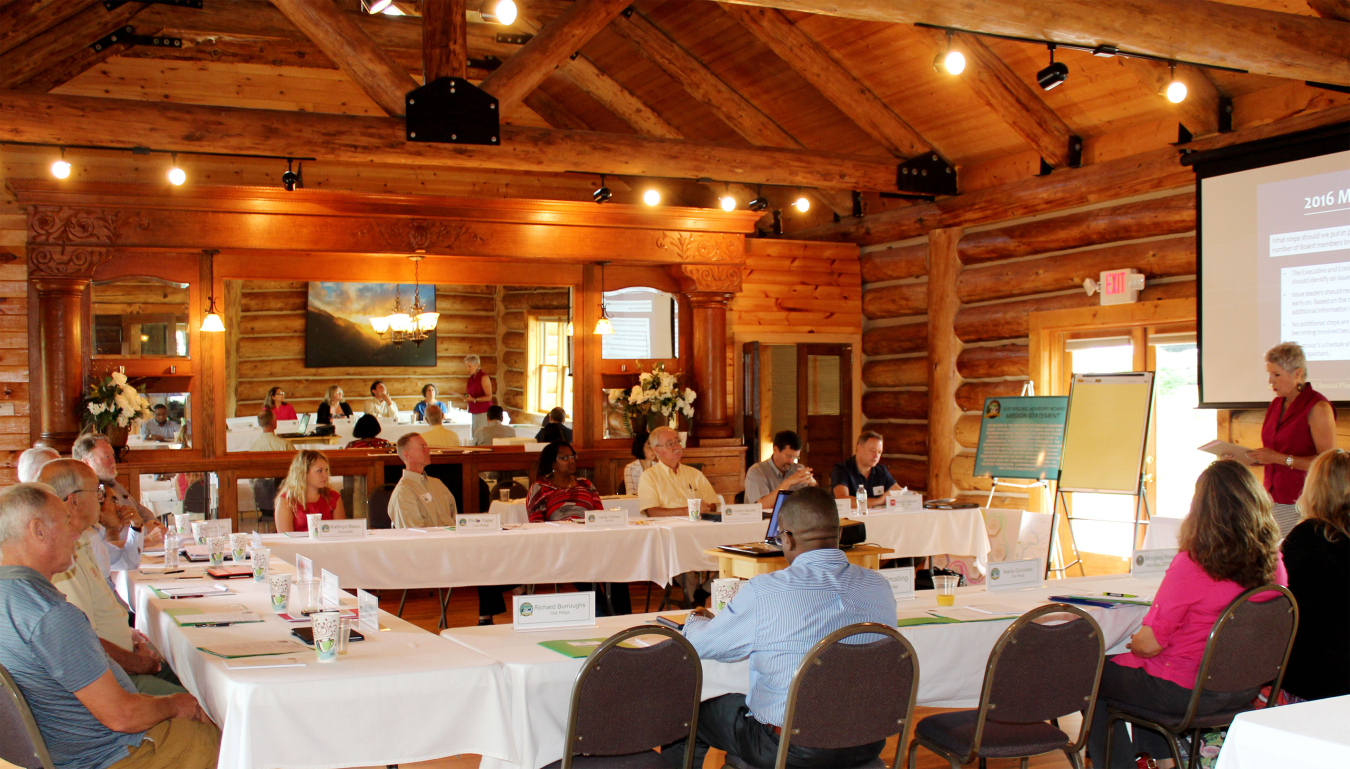
Oak Ridge advisory board members with representatives from DOE, EPA, and TDEC at FY 2017 planning meeting.
Media Contact: Ashley Huff
In August, members of a citizen’s advisory board met with representatives from the Department of Energy (DOE), the Environmental Protection Agency (EPA), and Tennessee Department of Environment and Conservation (TDEC) to consider key issues for Oak Ridge Reservation cleanup in fiscal year (FY) 2017, which begins this October.
The Oak Ridge Site Specific Advisory Board (ORSSAB) held its 2016 Annual Planning Meeting in Townsend, Tennessee, on August 6. The Saturday meeting brought together members of the Oak Ridge board, leadership from DOE’s Oak Ridge Office of Environmental Management (OREM), and liaisons from federal and state regulatory agencies to review cleanup accomplishments in FY 2016 and discuss priorities for FY 2017.
ORSSAB is a federally chartered citizens’ panel that provides recommendations to OREM on its environmental management activities at DOE sites locally. OREM encourages public participation in federal projects and meets regularly with the Oak Ridge board, as well as with other citizen and stakeholder groups within the community, to gather public perspectives regarding a diverse cleanup mission that addresses legacy nuclear waste at sites across the Oak Ridge Reservation through numerous activities, including waste disposition, long-term stewardship, and site restoration.
The primary purpose of ORSSAB’s annual meeting is to develop a work plan that will guide the board’s proceedings over the coming year and facilitate the process of making informed, timely recommendations to DOE that will benefit OREM’s FY17 planning and decision-making.
Sue Cange, OREM’s manager, opened the proceedings of the day-long workshop by welcoming ORSSAB’s new and returning members and leading presentations and discussions about OREM’s mission and the program’s near-term visions. She highlighted efforts concentrated at the East Tennessee Technology Park (ETTP) that recently culminated in the completion of “Vision 2016,” an achievement that marked the first time in the world that a site’s uranium enrichment processing buildings have been successfully demolished and removed.
“We are proud of a safe and successful accomplishment of Vision 2016, and as we embark on a new vision for 2020, we will continue to focus on our remaining work scope at the ETTP site to complete cleanup and reindustrialize the land,” said Cange.
ORSSAB Chair Belinda Price explained that the annual meeting provides a valuable opportunity for the board to gain insights from DOE, EPA, and TDEC on upcoming cleanup priorities and suggest topics for inclusion into the board’s FY17 work plan.
“DOE formulates a schedule of meetings and presentations to provide our members sufficient background information on key topics,” said Price, “but the work plan really develops out of the collaboration that takes place here and reflects our shared interests.”
DOE’s Dave Adler outlined potential topics the board could consider over the coming year. These included historic preservation activities at ETTP, sufficient waste disposal capacity, mercury-contaminated excess facilities at the Y-12 National Security Complex, groundwater issues, disposition of U-233 material at Oak Ridge National Laboratory (ORNL), and input on the annual budget request to Congress—a standing item on the work plan that ORSSAB customarily addresses each year in a recommendation on budget.
Representatives from EPA and TDEC also made presentations to the board and reviewed similar priorities. Kristof Czartoryski, the board’s TDEC liaison, added transuranic (TRU) waste processing to the list and encouraged funding for the TRU Sludge Processing Facility and advocated for removal of TRU waste from Trench 13 at ORNL. Jeff Crane, EPA Region 4 (Atlanta), emphasized greater implementation of the Groundwater Strategy as critical in the near term and stressed the need for an effective outreach program from DOE to inform and engage the community on federal projects.
Board members in turn reflected on the board’s recent accomplishments and the success of last year’s work plan. ORSSAB issued three recommendations to DOE in FY16, hosted a national conference, and participated in numerous public outreach activities and special events. Members were particularly enthusiastic about the schedule of site tours included in the previous work plan and looked forward to continuing the practice in FY17.
“They provide a unique opportunity to increase our hands-on knowledge and understanding of the issues, and I would encourage our new members especially to take part in these tours in the future,” said Greg Paulus, ORSSAB member since 2011.
DOE leadership acknowledged the hard work of ORSSAB’s members over the years and emphasized the board’s value to DOE in providing recommendations.
“We hope to continue a vibrant and mutually beneficial relationship with ORSSAB in the future,” said Cange.
The board’s new work plan for FY17 will be signed into effect before the fiscal year begins, which kicks off in October with the board’s first FY17 meeting on Wednesday, October 12.
The board regularly meets on the second Wednesday of each month at 6 p.m. at the DOE Information Center in Oak Ridge, located at 1 Science.gov Way. ORSSAB’s monthly meetings are free and open to the public.
For more information about the board or upcoming meetings, visit ORSSAB’s official website or contact support staff at (865) 241-4583 or (865) 241-4584. Follow ORSSAB on Facebook and YouTube.
